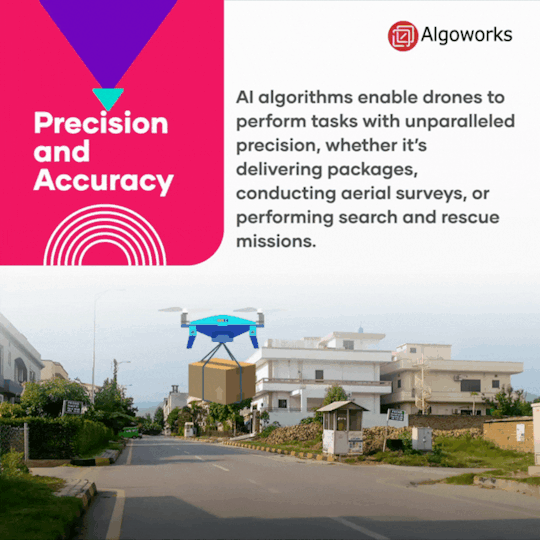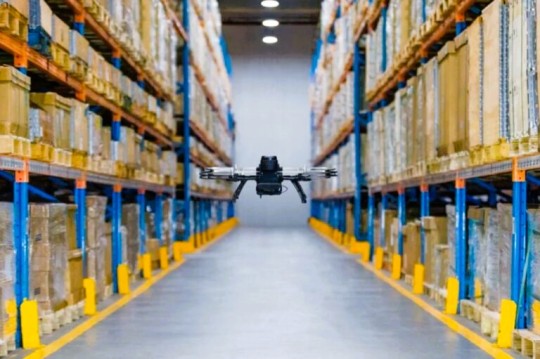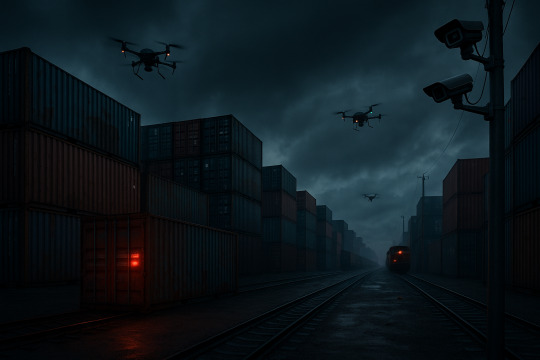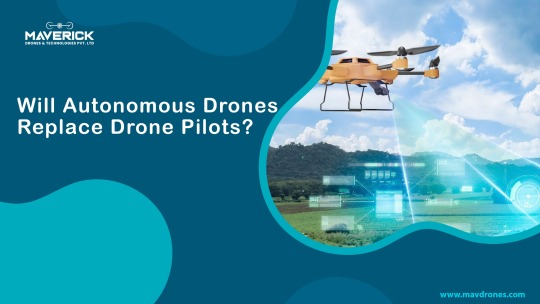#autonomous drones
Explore tagged Tumblr posts
Text
5 notes
·
View notes
Text





The integration of AI in drone technology is pushing the boundaries of what’s possible. From enhanced navigation to autonomous operations, AI is transforming the way drones are used across various industries.
Curious about the future of drones? Let’s dive into how AI is leading this revolution!
2 notes
·
View notes
Text
5G-Powered Drones: Ericsson, Qualcomm And Dronus Collaboration In Developing Autonomous Drone Solutions

5G mmWave technology for industrial use. Ericsson, Qualcomm, and Dronus Collaboration in developing autonomous drone solutions. The world of industrial automation is on the cusp of a revolution, and at the forefront is a powerful combination, of 5G technology and autonomous drones. A recent collaboration between Ericsson, Qualcomm Technologies, Inc., and Dronus provides a glimpse into this exciting future.
#5G drones#Industrial automation#Indoor drone applications#Warehouse inventory management#mmWave 5G technology#Autonomous drones#Industry 4.0#5G smart factory#(PoC)#Qualcomm QRB5165 processor#Telit Cinterion#mmWave#Industrial M.2 data card#5G Modem-RF System#Native mmWave connectivity#High-performance 5G connection#Bandwidth-intensive industrial operations#drone
2 notes
·
View notes
Text
Unclaimed containers, foreign-run ports, and AI drones—could they become America’s hidden threat? A speculative warning with real-world roots.

View On WordPress
#autonomous drones#BNSF railroads#drone warfare#logistics vulnerability#national security risk#Operation Rising Lion#port security#Speculative Fiction#unclaimed containers#US infrastructure
0 notes
Text
The Next War Could Be Drone-Driven
Experts warn that the future of warfare may shift away from massive ships. Instead, small, fast drones could become the new weapon of choice. Drones are cheaper and easier to produce than traditional warships. They can be launched quickly and in large numbers. This makes them perfect for quick strikes and surveillance.Some military analysts say drone carriers may replace super carriers in the…
#autonomous drones#drone carriers#drone technology#future warfare#global security#military defense#military innovation#modern warfare#Naval Strategy#weapon technology
0 notes
Text
How AI is Revolutionizing Drone Deliveries

The Drone Package Delivery Market is undergoing a significant transformation with the integration of artificial intelligence. AI is enabling autonomous navigation, real-time route optimization, and predictive analytics, making drone logistics more efficient and scalable. As demand for fast, cost-effective, and sustainable deliveries grows, AI-powered drones are becoming the backbone of next-generation supply chain management. Companies like Amazon Prime Air, UPS Flight Forward, and FedEx are leveraging AI-driven drone logistics to enhance last-mile delivery services. With continuous advancements in machine learning, 5G connectivity, and autonomous decision-making, AI is set to redefine the future of drone deliveries.
AI-Powered Navigation and Obstacle Avoidance for Drones
Autonomous drones rely on AI-driven navigation systems to operate efficiently in urban and rural environments. Machine learning algorithms process real-time data from LiDAR, cameras, and sensors to detect obstacles and optimize flight paths. AI-powered computer vision enhances situational awareness, allowing drones to avoid collisions and dynamically adjust their routes. Beyond Visual Line of Sight (BVLOS) operations are becoming feasible with AI-driven obstacle avoidance, enabling drones to cover longer distances without human intervention. As AI models continue to evolve, drone package delivery will become safer, more reliable, and more adaptable to diverse terrains.
How AI Enhances Drone Fleet Management
AI is revolutionizing drone fleet management by optimizing delivery schedules, monitoring drone health, and predicting maintenance needs. AI-driven fleet coordination ensures that multiple drones operate efficiently within urban airspace, reducing delays and maximizing delivery speed. Machine learning algorithms analyze traffic patterns, weather conditions, and airspace regulations to optimize flight paths in real time. Predictive maintenance powered by AI helps prevent technical failures, reducing downtime and operational costs. As the Drone Package Delivery Market scales up, AI-powered fleet management will be crucial in ensuring seamless operations.
AI and 5G: The Future of High-Speed Drone Connectivity
AI and 5G technology are driving the next wave of innovation in the Drone Package Delivery Market. 5G connectivity enables low-latency communication between drones and ground control systems, allowing real-time data exchange for efficient decision-making. AI-powered drones leverage edge computing to process data instantly, improving flight efficiency and reducing reliance on centralized cloud processing. The combination of AI and 5G enhances drone-to-drone communication, enabling swarm intelligence where multiple drones collaborate for faster deliveries. As 5G networks expand, AI-driven drones will unlock new possibilities for urban air mobility and commercial logistics.
Download Pdf Brochure: https://www.marketsandmarkets.com/pdfdownloadNew.asp?id=10580366
Enhancing Last-Mile Delivery with AI-Driven Drones
Last-mile delivery remains one of the most challenging aspects of logistics, but AI-powered drones are transforming this segment by reducing costs and improving speed. AI-driven route optimization ensures that drones choose the most efficient paths, minimizing delivery times. Smart delivery scheduling powered by AI predicts customer demand patterns, allowing companies to deploy drones proactively. AI-enabled automated customer interactions enhance the delivery experience, providing real-time updates and adaptive scheduling. As e-commerce demand surges, AI-driven drone deliveries will become a critical component of last-mile logistics.
AI and Blockchain: Securing the Drone Package Delivery Market
Security and transparency are vital in drone logistics, and AI combined with blockchain technology is addressing these concerns. AI-driven authentication systems enhance drone security by verifying identities and preventing unauthorized access. Blockchain ensures secure transaction records, reducing fraud in drone package delivery operations. AI-powered fraud detection algorithms analyze delivery patterns to identify suspicious activities in real time. The integration of AI and blockchain strengthens data integrity, making drone logistics more reliable and secure.
AI-Powered Medical Drone Deliveries: Transforming Healthcare Logistics
AI is playing a crucial role in medical drone deliveries, ensuring the safe and timely transportation of critical supplies. AI-powered drones are used to deliver vaccines, blood samples, and emergency medications to remote and disaster-stricken areas. Machine learning algorithms optimize delivery routes for urgent medical shipments, reducing response times. AI enhances cold chain management for temperature-sensitive medical products, ensuring that supplies remain intact during transit. With AI-driven automation, medical drone deliveries are improving healthcare accessibility and saving lives.
Addressing AI-Driven Drone Delivery Challenges
Despite the advancements, AI-powered drone delivery faces challenges such as regulatory restrictions, public acceptance, and ethical concerns. AI decision-making in autonomous drones raises questions about accountability in case of delivery failures or accidents. AI biases in flight path selection and risk assessment must be addressed to ensure fair and safe drone operations. Public concerns regarding AI-powered surveillance drones require transparency in AI algorithm governance. As regulatory bodies refine policies for AI in drone logistics, the industry must work towards ethical and safe deployment of AI-driven delivery systems.
AI in Sustainable Drone Logistics
AI is contributing to the sustainability of the Drone Package Delivery Market by optimizing energy consumption and reducing carbon footprints. AI-driven flight path optimization minimizes unnecessary energy use, making drone deliveries more fuel-efficient. Smart battery management powered by AI extends drone flight endurance and reduces battery waste. AI-powered carbon tracking systems help logistics companies monitor and reduce their environmental impact. By integrating AI with sustainable drone technology, the industry is moving towards a greener and more eco-friendly logistics ecosystem.
Ask For Sample Report: https://www.marketsandmarkets.com/requestsampleNew.asp?id=10580366
Future Trends: AI and the Next Decade of Drone Deliveries
The next decade will witness significant advancements in AI-powered drone logistics, shaping the future of package delivery. AI-driven air traffic management systems will enable large-scale drone operations in urban environments. Machine learning will continue to refine autonomous decision-making, making drone deliveries more precise and adaptable. AI-powered predictive analytics will enhance logistics planning, reducing inefficiencies in the supply chain. As AI technology matures, drones will become an integral part of global logistics, revolutionizing how goods are transported. The Drone Package Delivery Market will continue to evolve, driven by AI innovations that enhance efficiency, security, and sustainability.
What’s Next for AI in the Drone Package Delivery Market?
The AI-driven Drone Package Delivery Market is on the brink of widespread adoption, with advancements in automation, connectivity, and security accelerating its growth. AI-powered drones are transforming last-mile logistics, medical deliveries, and urban air mobility, redefining the future of commercial transportation. As regulatory frameworks evolve, AI will play a central role in ensuring safe and efficient drone operations. The integration of AI with 5G, blockchain, and sustainability initiatives will unlock new possibilities for drone logistics. With continuous innovations, the future of AI in the Drone Package Delivery Market is poised for exponential growth, creating a more efficient, connected, and intelligent logistics ecosystem.
#drone package delivery market#ai in drone delivery#autonomous drones#ai-powered logistics#drone navigation ai#machine learning drones#ai fleet management#drone last-mile delivery#ai-driven drone security#ai drone sustainability#smart drones logistics
0 notes
Text
#artificial intelligence#ai border surveillance#asylum seekers#united states#europe#autonomous drones#border security
1 note
·
View note
Text

Will Autonomous Drones Replace Drone Pilots?
The Rise Of Autonomous Drones
Autonomous drones are all the rage these days. They can fly, navigate, and complete tasks without human intervention. From delivering packages to surveying lands, these drones are transforming industries. But does that mean they will replace human drone pilots? Not so fast.
Why Pilots Are Still Important
Despite the advancements, drone pilots are not going anywhere. Human touch is crucial. Pilots bring creativity and problem-solving skills to the table. Autonomous drones follow algorithms, but they cannot adapt like humans can. Imagine a drone stuck in a tree. A pilot can quickly figure out a solution, but a drone might just stay stuck.
Safety First
Safety is another reason pilots are irreplaceable. Autonomous drones rely on sensors and software. Any glitch can lead to accidents. Human pilots can take over in emergencies, ensuring safety. Human pilots also handle complex environments better, like crowded cityscapes or unpredictable weather.
The Best Of Both Worlds
The future is not about choosing between drones and pilots. It is about combining their strengths. Autonomous drones can handle routine tasks, while pilots manage complex missions. This partnership increases efficiency and reduces costs. Plus, it creates more job opportunities. Pilots can now focus on strategy and planning, leaving mundane tasks to drones.
Training And Expertise
Pilots need training and expertise to operate drones. Autonomous drones still require human oversight. Pilots ensure that drones follow regulations and perform optimally. As technology evolves, the role of pilots will shift but remain crucial.
The Final Answer
So, will autonomous drones replace drone pilots? No. They will work together, creating a powerful synergy. Autonomous drones enhance efficiency, but pilots provide an irreplaceable human touch. The future looks bright with this dynamic duo leading the way.
Ready To Fly?
Embrace the future of drones. Whether you are a tech enthusiast or a professional pilot, the skies are open for innovation. Let us soar higher together! If you want to explore some of the latest autonomous drones that are making waves in the market, do visit this PAGE.
0 notes
Text
Autonomous Window Delivery Drones
I imagined an invention for delivering take away food to high-rise apartments or business offices in built up city environments.
customers buy a delivery device from a retailer which they can attach and detach from the outside of an open window. the attachment to the window is accepting of an autonomous incoming delivery drone. the delivery drone is part of a delivery service from partaking food suppliers.
a customer orders food. the supplier attaches the order to the delivery drone. the drone takes off vertically to a safe height then navigates towards the delivery device of the awaiting window. when the drone arrives at the window it hovers, unhooks its delivery, attaching its parcel to the awaiting window device. no need for landing. no need to use elevators or stairs. no hassle. the drone then returns to the food service provider it arrived from - lowering vertically onto its return location.
this business start-up would supply both the drones to the takeaway retailers providing the food plus the window attachments to the city retail outlets providing for customers.
high-rise office building businesses and high-rise private home customers would be the target consumer
0 notes
Text




Suzuki Electric Mobility Base Unit, 2024. Another CES debutant, an autonomous platform that can be adapted by third parties for a variety of uses. Everblue Technologies have used the Base Unit to create a drone snow plough which they are planning to drink to market in early 2026. It can also be used for light deliveries
#Suzuki#Suzuki Electric Mobility Base Unit#EV#electric vehicle#autonomous#drone#base unit#CES#snow plough#autonomous snow plough#2026
83 notes
·
View notes
Text

#would they be good at asmr#uzi doorman#murder drones uzi#md uzi#uzi md#uzi murder drones#murder drones#md#murder drones fandom#murder drones au#murder drones poll#md fandom#md au#md uzi doorman#murder drones reference#glitch productions#liam vickers animation#elsie lovelock#youtube#youtube series#asmr#asmr sounds#autonomous sensory meridian response#asmrtist#polls#random polls#tumblr polls#fun polls#character polls#fandom polls
21 notes
·
View notes
Text

youtube
2 notes
·
View notes
Text
Whenever someone asks my favourite show i stop myself from doing uzi's presentation speech thing
*THROWS N AT YOU*

*scurries away to draw*
#Murder drones#WE ARE WORKER DRONES AUTONOMOUS ROBOTS DESIGNED TO MINE EXOPLANETS FOR OUR PARENT COMPANY JC JESNSON IN SPAAA--
16 notes
·
View notes
Text
11 notes
·
View notes
Text
S1 Contestant Update #1: Hunter


"Did you know that Workers and Disassemblers can make a kid together? I didn't either until Hunter showed up! Supposedly the offspring of Copper-9's heroes, he's been on the run on the surface for some reason. Find it hard to believe life back at home could possibly be worse than here, but maybe that initiative will get Hunter through to the end~" - Fractal, Hostess/Commentator of Hunger Drones
\\ Submitted by @autonomous-helper //
\\ Two open slots remaining //
#hunger drones#murder drones#murder drones oc#murder drones rp#hunger drones s1#{ showtime~! } fractal#contestant announcement#hunger games simulator#autonomous helper
4 notes
·
View notes
Text

CAPTCHAs tech companies exploiting free labor to train AI vision for defense contractors military drones and autonomous weapons
#CAPTCHAs tech companies exploiting free labor to train AI vision for defense contractors military drones and autonomous weapons#captchas#tech companies#technology#tech#companies#fuck corporations#exploitation#exploitative#free labor#free labour#ai generated#ai art#ai artwork#ai girl#ai#a.i. generated#a.i. art#a.i.#artificial intelligence#military#army#navy#air force#fuck the military#anti military#military industrial complex#adf#adfa#australiandefenceforce
14 notes
·
View notes